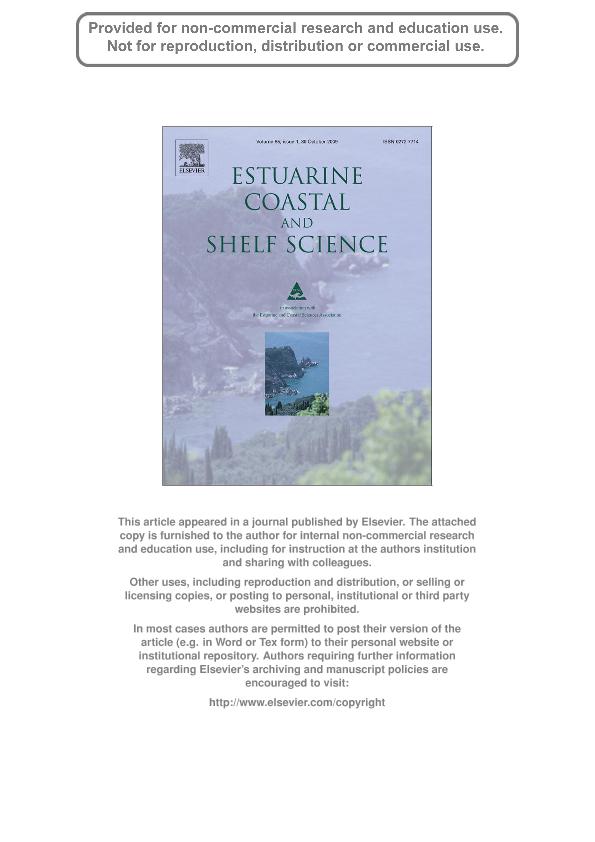Mostrar el registro sencillo del ítem
dc.contributor.author
Arias, Andres Hugo

dc.contributor.author
Spetter, Carla Vanesa

dc.contributor.author
Freije, Rubén Hugo

dc.contributor.author
Marcovecchio, Jorge Eduardo

dc.date.available
2017-11-15T21:50:23Z
dc.date.issued
2009-12
dc.identifier.citation
Arias, Andres Hugo; Spetter, Carla Vanesa; Freije, Rubén Hugo; Marcovecchio, Jorge Eduardo; Polycyclic aromatic hydrocarbons (PAHs) distribution in water column, native mussels (Brachydontes sp and Tagelus sp) and fish (Odontesthes sp) from an industrialized South American estuary; Elsevier; Estuarine, Coastal and Shelf Science; 85; 1; 12-2009; 67-81
dc.identifier.issn
0272-7714
dc.identifier.uri
http://hdl.handle.net/11336/28309
dc.description.abstract
Polycyclic aromatic hydrocarbons (PAHs), one of the major groups of anthropogenic environmental pollutants, were firstly identified and measured in coastal waters, native mussels and fish of an industrialized South American estuary. The aim of this study was to measure the PAHs concentrations and evaluate distribution and sources in surface seawater, native mussels Brachidontes sp. and Tagelus sp.) and fish (Odontesthes sp.) from various coastal sites of the Bahı´a Blanca Estuary, in order to put the estuary in a global context and assess it ecotoxicological risk. For this, 40 samples of surface water were collected between August 2004 and February 2006 and analyzed by GC/MS for 17 PAHs, including the 16 EPA priority PAHs. In addition, main physicochemical parameters, nutrients and pigments were simultaneously obtained as key parameters to evaluate possible relationships. Finally, several native mussel communities and fish specimens were also analyzed for PAHs contents. The area of study is located at the Argentinean coast and presents an intensive human and industrial activity at the north shoreline. Total PAHs (S17 PAHs) in whole surface waters ranged from undetected to more than 4 mg/l. Seasonal PAHs levels relationship with master parameters suggested a relationship between the phytoplankton microbiological cycling and the dissolved/suspended PAHs occurrence in water. In addition, Cluster Analysis was performed to identify the homogeneous groups of individual PAHs in water and Principal Component Analysis to extract underlying common factors. The result of PCA was similar to that of the cluster analysis; both could differentiate two subsets of pyrogenic sources and a petrogenic origin. PAHs levels in indigenous mussels (Brachidontes sp. and Tagelus sp.) ranged from 348 to 1597 ng/g (dry weight). Fish specimens (Odontesthes sp.) showed a mean concentration of 1095 ng/g d.w. in whole tissues. Mussel source ratios and PCA results were in good agreement with the dominant sources assessed for water samples and further enabled the linking of PAHs origins according to the sample location. The Bahı´a Blanca Estuary wide mean of the PAHs burden in mussels showed that the average PAH contamination level was within the ??moderate?? category. Levels appeared as ecotoxicologically risk safe for the inner stations; however, they were exceeding various safety criterions at the outer. Results indicate the needing of a systematic monitoring program for the area of study, in order to provide accurately assessment and management of risks for the regional population.
dc.format
application/pdf
dc.language.iso
eng
dc.publisher
Elsevier

dc.rights
info:eu-repo/semantics/openAccess
dc.rights.uri
https://creativecommons.org/licenses/by-nc-sa/2.5/ar/
dc.subject
Aromatic Hydrocarbons
dc.subject
Water Pollution
dc.subject
Aqcuatic Organisms
dc.subject
Argentine
dc.subject.classification
Meteorología y Ciencias Atmosféricas

dc.subject.classification
Ciencias de la Tierra y relacionadas con el Medio Ambiente

dc.subject.classification
CIENCIAS NATURALES Y EXACTAS

dc.title
Polycyclic aromatic hydrocarbons (PAHs) distribution in water column, native mussels (Brachydontes sp and Tagelus sp) and fish (Odontesthes sp) from an industrialized South American estuary
dc.type
info:eu-repo/semantics/article
dc.type
info:ar-repo/semantics/artículo
dc.type
info:eu-repo/semantics/publishedVersion
dc.date.updated
2017-11-03T19:04:03Z
dc.journal.volume
85
dc.journal.number
1
dc.journal.pagination
67-81
dc.journal.pais
Países Bajos

dc.journal.ciudad
Amsterdam
dc.description.fil
Fil: Arias, Andres Hugo. Consejo Nacional de Investigaciones Científicas y Técnicas. Centro Científico Tecnológico Conicet - Bahía Blanca. Instituto Argentino de Oceanografía. Universidad Nacional del Sur. Instituto Argentino de Oceanografía; Argentina. Universidad Nacional del Sur; Argentina
dc.description.fil
Fil: Spetter, Carla Vanesa. Consejo Nacional de Investigaciones Científicas y Técnicas. Centro Científico Tecnológico Conicet - Bahía Blanca. Instituto Argentino de Oceanografía. Universidad Nacional del Sur. Instituto Argentino de Oceanografía; Argentina. Universidad Nacional del Sur; Argentina
dc.description.fil
Fil: Freije, Rubén Hugo. Universidad Nacional del Sur; Argentina
dc.description.fil
Fil: Marcovecchio, Jorge Eduardo. Consejo Nacional de Investigaciones Científicas y Técnicas. Centro Científico Tecnológico Conicet - Bahía Blanca. Instituto Argentino de Oceanografía. Universidad Nacional del Sur. Instituto Argentino de Oceanografía; Argentina. Universidad FASTA "Santo Tomas de Aquino"; Argentina
dc.journal.title
Estuarine, Coastal and Shelf Science

dc.relation.alternativeid
info:eu-repo/semantics/altIdentifier/url/http://www.sciencedirect.com/science/article/pii/S0272771409002893
dc.relation.alternativeid
info:eu-repo/semantics/altIdentifier/doi/http://dx.doi.org/10.1016/j.ecss.2009.06.008
Archivos asociados
